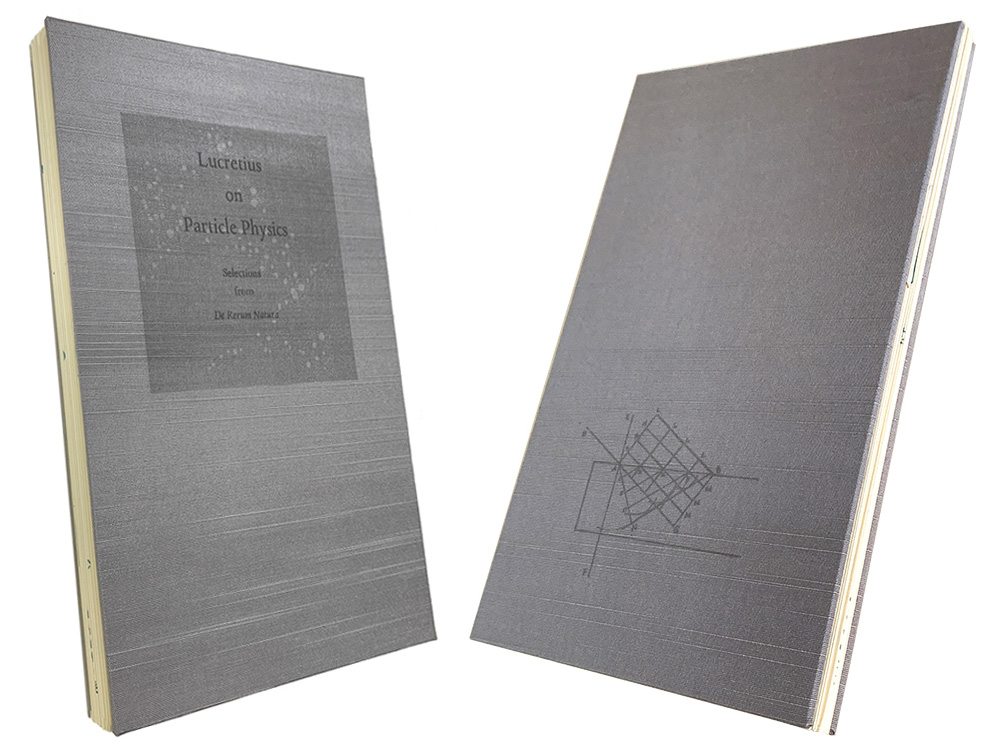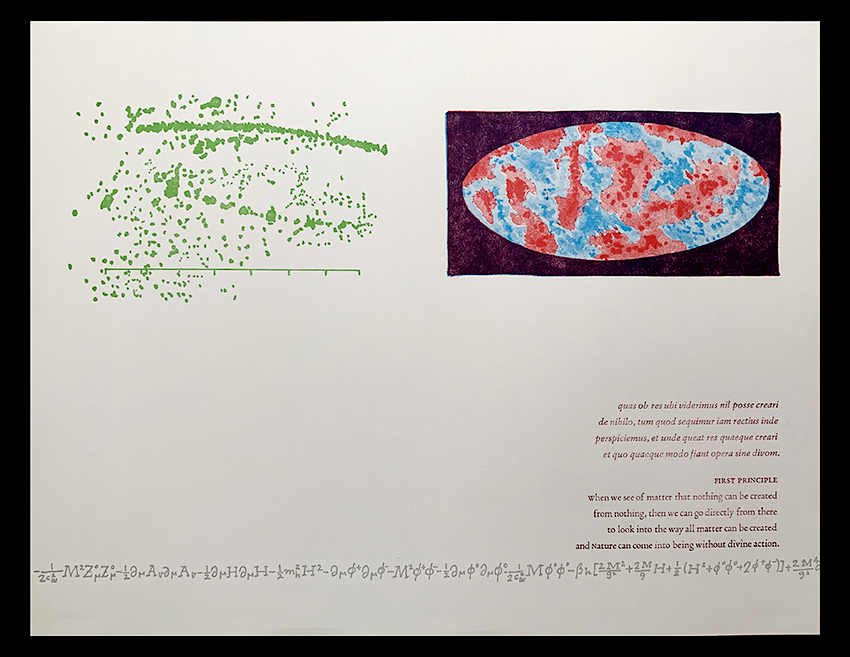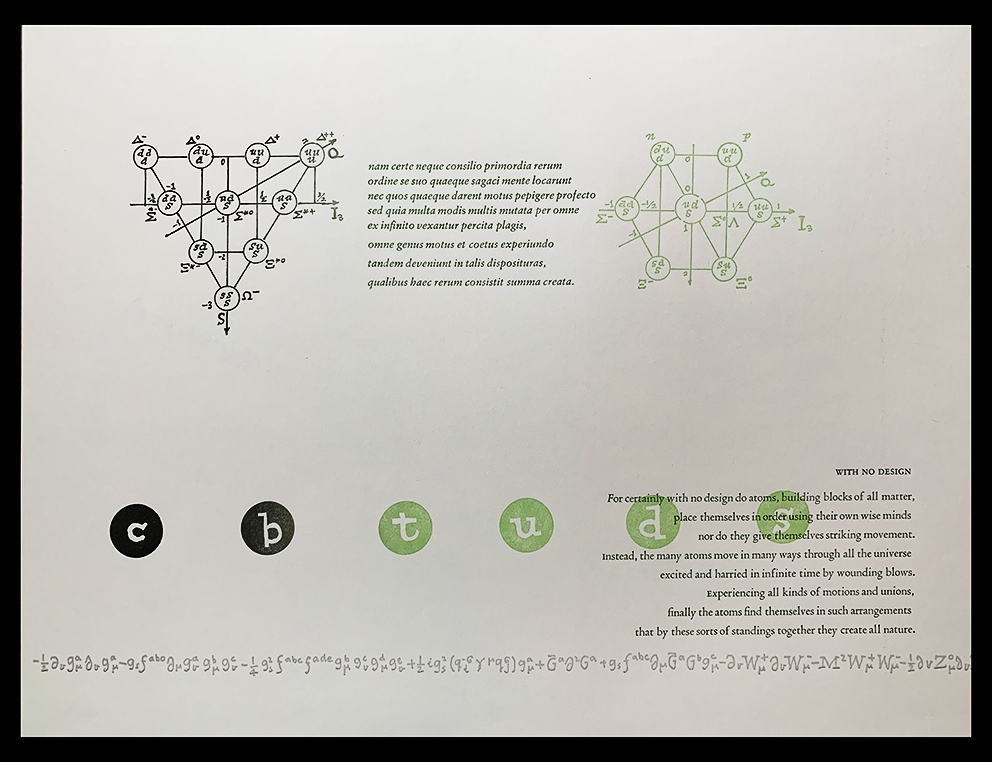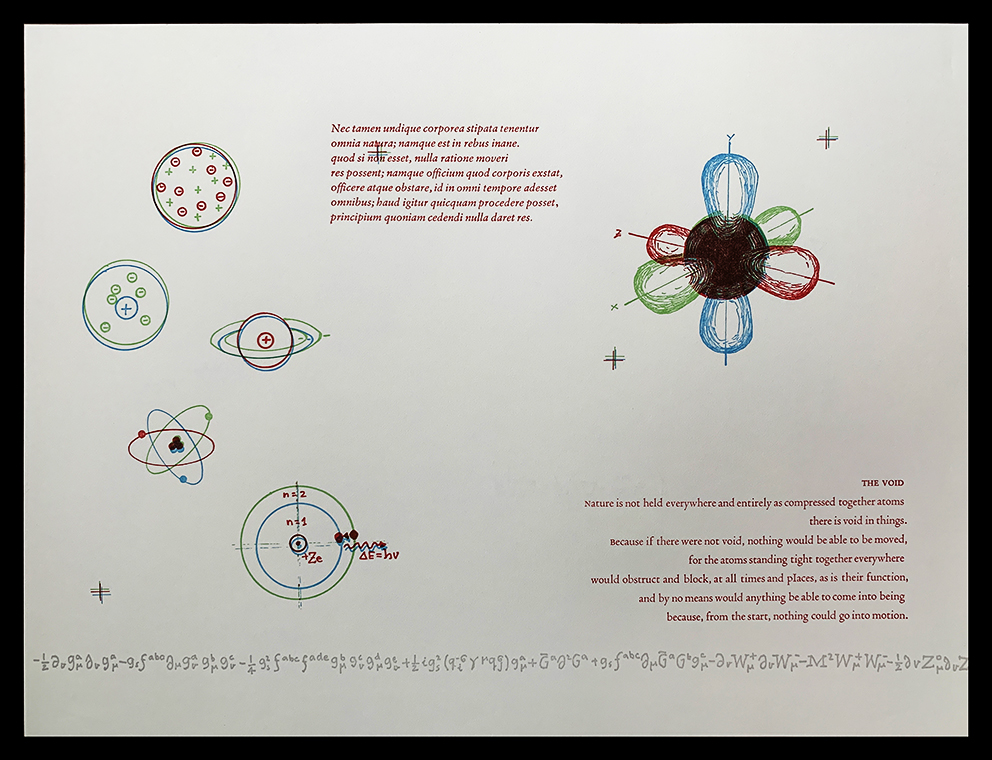





Lucretius on Particle Physics, Selections from De rerum natura
Dean Robino, Translations and Illustrations
Quelquefois Press, 2022
Lucretius’s poems about Epicurean atomic theory including the Swerve in Latin and translated, with illustrations from modern physics and cosmology.
From the colophon:
First, my friend Robert Laws suggested our Latin group read De rerum natura1Robert’s suggestion was based in part on a New York Review essay on Stephen Greenblatt’s The Swerve, Anthony Grafton “The Most Charming Pagan,” December 8, 2011, The New York Review, https://www.nybooks.com/articles/2011/12/08/most-charming-pagan/ Greenblatt’s book itself is highly recommended., Lucretius’s didactic poem on the philosophy of Epicurus, who followed Democritus’s atomic theory. Atoms2Atom, to quote Websters, Middle English, from Latin atomus, from Greek atomos, from atomos indivisible, from a- + temnein to cut. The a is the alpha privative meaning not. are no longer the smallest components of matter, but Lucretius’s first bodies foresee 20th century ideas.3Including for example, matter not coming from nothing or going back to nothing, first bodies being too small to see, the void in the universe and within atoms themselves, the randomness underlying events. His swerve, the randomness in atoms’ coming together, is consistent with quantum mechanical concepts.4The uncertainty principle, the superposition principle, Einstein’s dislike for physics based on dice throws, the elementary particles of the Standard Model, images from objects entering our eyes, free will, etc. Second, my friend and calligraphy teacher Carla Tenret suggested I take Mary Laird’s one day introduction to letterpress. I was immediately converted. Soon after, Mary and Carla invited me to join their weekly adventures on Mary’s press. What better to set than Lucretius. As those selections evolved into a book, how better to illustrate than with images from quantum mechanics and particle physics.5Which physicists and graphic designers so generously make available online. For example, Wikipedia, https://en.wikipedia.org/wiki/Particle_physics and https://en.wikipedia.org/wiki/Standard_Model and the many links therefrom. I thank Mary for her guidance and advice at every stage and Carla for her ideas and for ensuring mine were grounded and both for the great pleasure of working with them.
Centaur, Sabon Antiqua, Dante; Baskerville and illustrations in polymer plates by Crown Flexo; colors are the blue, red, and green6Process blue U, red 032 U, green 368 U. used in particle physics illustrations; printed on Holcomb Superfine; accordion bound by author and friends in Japanese book cloth from Campbell-Logan.
Additional thank you’s: Lars Kim, for helping me understand the files for polymer plate printing; Lars and John Sullivan for the early plates; Mary Laird, for all her work on binding; Kris Nevius for her close proofreading of the acknowledgement pages; Kathy Kuehn, for her guidance on scoring, folding, and gluing text blocks; Charles Robino for his help with and advice about tools; Thomas Gutierrez, professor, Department of Physics at California Polytechnic State University for posting the Standard Model in the Lagrangian form, a small portion of which is the footer on front pages of the book; the friends who supported and encouraged me throughout the whole process, Victoria Lee, Kris Nevius, and especially Annell Kocher.
Footnotes
- Robert’s suggestion was based in part on a New York Review essay on Stephen Greenblatt’s The Swerve, Anthony Grafton “The Most Charming Pagan,” December 8, 2011, The New York Review, https://www.nybooks.com/articles/2011/12/08/most-charming-pagan/ Greenblatt’s book itself is highly recommended.
- Atom, to quote Websters, Middle English, from Latin atomus, from Greek atomos, from atomos indivisible, from a- + temnein to cut. The a is the alpha privative meaning not.
- Including for example, matter not coming from nothing or going back to nothing, first bodies being too small to see, the void in the universe and within atoms themselves, the randomness underlying events.
- The uncertainty principle, the superposition principle, Einstein’s dislike for physics based on dice throws, the elementary particles of the Standard Model, images from objects entering our eyes, free will, etc.
- Which physicists and graphic designers so generously make available online. For example, Wikipedia, https://en.wikipedia.org/wiki/Particle_physics and https://en.wikipedia.org/wiki/Standard_Model and the many links therefrom,
- Process blue U, red 032 U, green 368 U.
For further reading
- Gutierrez, Thomas D. “Standard Model Lagrangian (density).” http://nuclear.ucdavis.edu/~tgutierr/files/stmL1.html. Accessed 1 Mar. 2022.
- Shivni, Rashmi. “The Deconstructed Standard Model Equation.” Symmetry Magazine, www.symmetrymagazine.org/article/the-deconstructed-standard-model-equation. Accessed 1 Mar. 2022.
- Rehmeyer, Julie. “Do subatomic particles have free will?” Science News, 15 Aug. 2008. https://www.sciencenews.org/article/do-subatomic-particles-have-free-will Accessed 15 Apr. 2022.
- Greenblatt, Stephen. The Swerve : How the World Became Modern. New York, W.W. Norton & Company, 2012.
- Titus Lucretius Carus, G. Benfield and R. C. Reeves. Selections from Lucretius. London, Oxford University Press, 1967.
- Titus Lucretius Carus and Bonnie A Catto. Selections from de Rerum Natura. Wauconda, Il, Bolchazy-Carducci Publishers, 1998.
Footnotes
- 1Robert’s suggestion was based in part on a New York Review essay on Stephen Greenblatt’s The Swerve, Anthony Grafton “The Most Charming Pagan,” December 8, 2011, The New York Review, https://www.nybooks.com/articles/2011/12/08/most-charming-pagan/ Greenblatt’s book itself is highly recommended.
- 2Atom, to quote Websters, Middle English, from Latin atomus, from Greek atomos, from atomos indivisible, from a- + temnein to cut. The a is the alpha privative meaning not.
- 3Including for example, matter not coming from nothing or going back to nothing, first bodies being too small to see, the void in the universe and within atoms themselves, the randomness underlying events.
- 4The uncertainty principle, the superposition principle, Einstein’s dislike for physics based on dice throws, the elementary particles of the Standard Model, images from objects entering our eyes, free will, etc.
- 5Which physicists and graphic designers so generously make available online. For example, Wikipedia, https://en.wikipedia.org/wiki/Particle_physics and https://en.wikipedia.org/wiki/Standard_Model and the many links therefrom.
- 6Process blue U, red 032 U, green 368 U.
Book
9.5 x 6.12 x 0.75 inches
Edition
50
No. of Pages
72
Price
$575. CA residents add 10.25% tax. Shipping and insurance additional.
Category
Bookbinding, Letterpress
